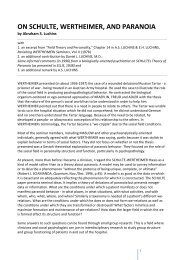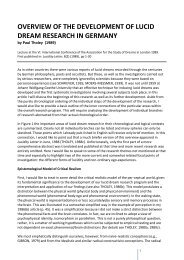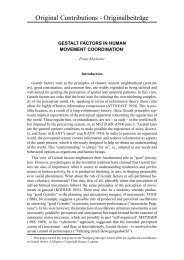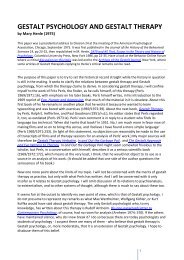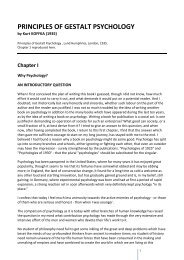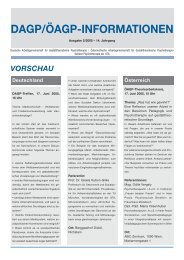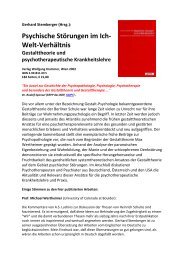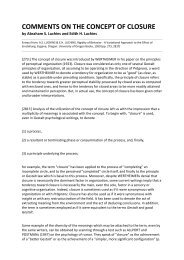pdf-Download - Society for Gestalt Theory and its Applications (GTA)
pdf-Download - Society for Gestalt Theory and its Applications (GTA)
pdf-Download - Society for Gestalt Theory and its Applications (GTA)
Create successful ePaper yourself
Turn your PDF publications into a flip-book with our unique Google optimized e-Paper software.
hatte es abgelehnt, sich selbst durch eine Scheidung von ihm in Sicherheit zu bringen) - es war<br />
jedoch bere<strong>its</strong> zu spät. Die 'Endlösung des Judenproblems' riss Kurt und Greta GRELLING mit sich -<br />
sie wurden in das KZ Auschwitz abtransportiert, wo sie am 18. September 1942 ankamen. Noch<br />
am selben Tag oder kurz darauf wurden sie in den Gaskammern ermordet.<br />
Eine neuere Zusammenstellung der Publikationen von GRELLING im Internet (von Volker<br />
PECKHAUS) enthält mehr als 250 Arbeiten zwischen 1911 und 1922. GRELLING’s 1924<br />
veröffentlichtes Buch über Mengenlehre wurde 1943 ins Spanische übersetzt. Das Interesse an<br />
GRELLING’s Arbeit nimmt zu. Den Nazis ist es nicht gelungen, die Flamme zum Erlöschen zu<br />
bringen!<br />
Contents of the Biography<br />
<br />
<br />
<br />
<br />
<br />
<br />
<br />
<br />
GRELLINGs Paradox, NELSON, <strong>and</strong> BORN<br />
Lebenslauf <strong>and</strong> Family Matters<br />
GRELLING, the Berlin Group, <strong>and</strong> REICHENBACH<br />
OPPENHEIM <strong>and</strong> HEMPEL<br />
The Final Years of Kurt GRELLING<br />
Epilogue<br />
Acknowledgements<br />
Notes<br />
Kurt GRELLING (1886-1942) was probably best known <strong>for</strong> the paradox or antinomy that bears his<br />
name; it was also called the "not autological" or the "heterological" paradox.[1] Paul OPPENHEIM<br />
wrote to us in 1964 that GRELLING was famous <strong>for</strong> this paradox. In recent years GRELLING, as well<br />
as OPPENHEIM, have become known <strong>for</strong> their analysis of <strong>Gestalt</strong> concepts. [The article on <strong>Gestalt</strong><br />
as a functional whole by GRELLING <strong>and</strong> OPPENHEIM <strong>and</strong> our Overview of it appeared in <strong>Gestalt</strong><br />
<strong>Theory</strong>, 21 (1/1999), pp. 49-54 <strong>and</strong> pp. 43-48 respectively.]<br />
GRELLINGs Paradox, NELSON, <strong>and</strong> BORN<br />
In the winter term 1905/1906, GRELLING came to study at the University of Göttingen, worldfamous<br />
<strong>for</strong> mathematics <strong>and</strong> <strong>for</strong> the great David HILBERT (1862-1943). HILBERTs ef<strong>for</strong>ts to<br />
axiomatize mathematics were shaken, as were the entire foundations of mathematics, by the<br />
announcement in 1903 of Bertr<strong>and</strong> RUSSELLs antinomy or paradox.[2]<br />
In a biography of HILBERT, Constance REID (1970) wrote:<br />
By 1904, after <strong>its</strong> publication by RUSSELL, the antinomy was having - in HILBERTs opinion - a<br />
"downright catastrophic effect" in mathematics. One after another, the great gifted workers in set<br />
theory ... had all withdrawn from the field, conceding defeat. The simplest <strong>and</strong> most important<br />
deductive methods, the most ordinary <strong>and</strong> fruitful concepts seemed to be threatened, <strong>for</strong> this<br />
3



